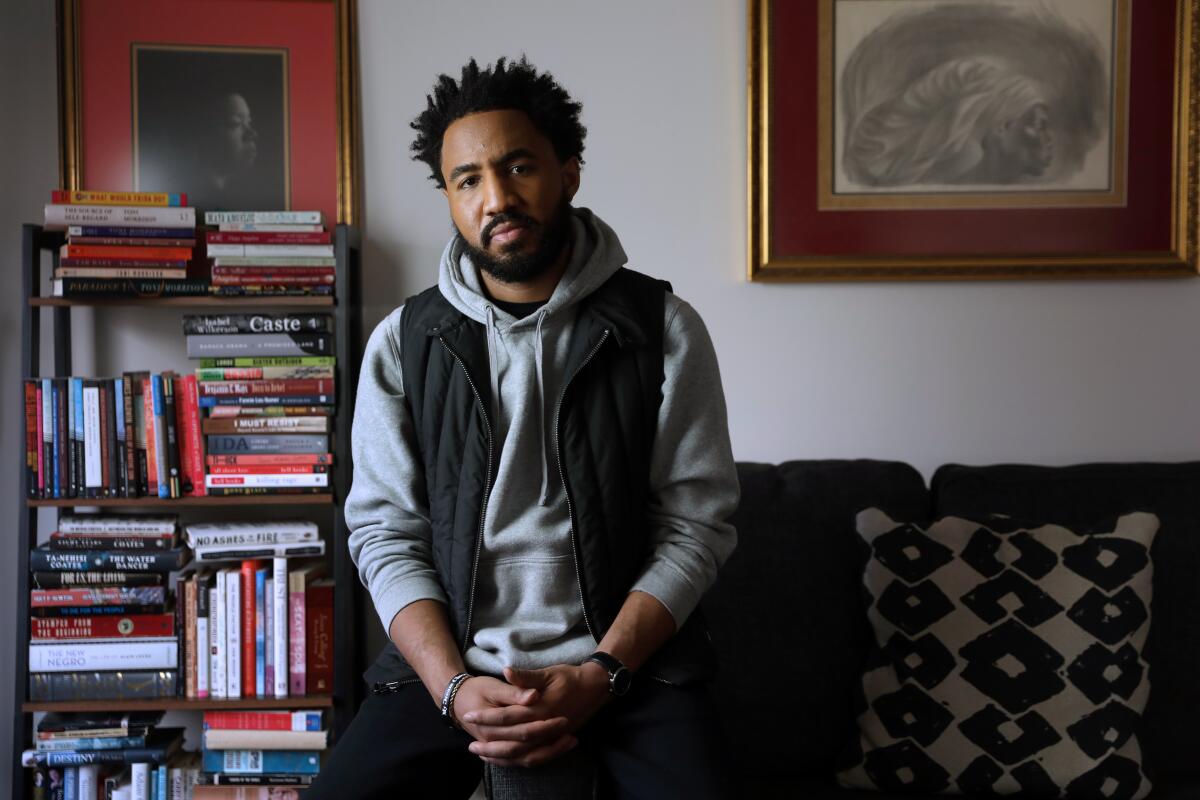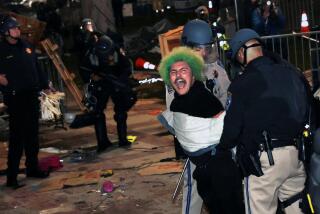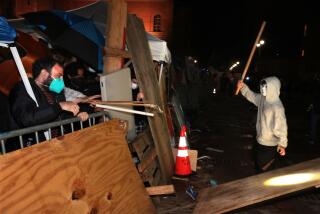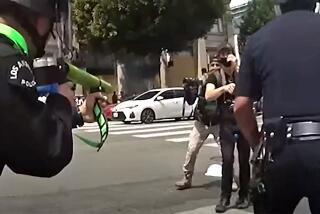Sidelined from protests after an injury, L.A. man sues to ban police projectiles

- Share via
Deon Jones is one of those people who sees civil rights work and political activism as a personal mission, indistinguishable from everyday life.
Only 29, he grew up in Mississippi watching Ku Klux Klan members march near his grandmother’s house, and says it inspired him to work for change.
He wrote his thesis at American University on the history of the civil rights movement under the tutelage of Julian Bond. He interviewed Maya Angelou and was mentored by U.S. Rep. John Lewis. He interned in the Obama White House and worked on the political campaign of Stacey Abrams in Georgia.
But in recent months, Jones has felt sidelined in Los Angeles, where he now lives, as protests over police brutality and other political and criminal justice issues have continued to play out in the streets.
After a Los Angeles police officer shot Jones in the face with a projectile during a major protest in May, his doctor told him he was lucky to be alive — and might not be if he were struck in a similar way a second time. So, fearing for his life, Jones said he kept off the streets, feeling his political voice had been stifled.
Until now.
On Wednesday, Jones filed a federal lawsuit against the city of L.A. and the Los Angeles Police Department, alleging that his constitutional rights were violated when he was targeted and wounded by the officer who fired the projectile at his face in violation of department policy.
He is demanding personal compensation, but also something more substantive: an end to the LAPD’s use of projectile weapons to quell protests or other political demonstrations.
“My intention is to put an end to LAPD’s use of rubber bullets,” Jones said in an interview, using a colloquial term for the hard-foam and plastic projectiles that LAPD officers have used against him and other protesters in recent months. “We have a constitutional right to peacefully protest, and nobody should be afraid that their decision to protest peacefully will land them injured or dead.”
The LAPD said the incident is under investigation, but declined to comment on the litigation. The department has said it investigates all cases in which police force results in someone being hospitalized. It also is conducting a broad review of its handling of the summer protests.
Jones’ lawsuit adds to a growing mountain of litigation against the city over the LAPD’s handling of protests this summer — particularly near the Grove in the Fairfax area after a protest ballooned out of Pan Pacific Park on May 30, which is when Jones was injured.
Already, the city is being sued by Black Lives Matter Los Angeles and the National Lawyers Guild in a major lawsuit that seeks class status for thousands of protesters and also aims to ban projectile weapons at future protests. The city also is facing other lawsuits from individual protesters who were personally injured by police in the fray.
Swirling around the litigation from this summer is a widening debate around the efficacy of such projectile weapons — which has been further called into question by the LAPD’s continued use of them at more recent protests and gatherings, including after the Lakers’ NBA title victory and the Dodgers’ World Series win this year.
One man reported having his eye “exploded” by a police projectile after the Lakers’ victory, drawing condemnations for the extreme force from his surgeon and from state lawmakers, including one who recently reintroduced legislation in Sacramento that would further regulate the weapons and bar their use in quelling protests statewide.
The LAPD has repeatedly defended its use of projectile weapons, saying they are a necessary tool to protect officers and clear crowds that have turned unruly and violent. LAPD Chief Michel Moore has repeatedly said such weapons have only been used when officers were taking incoming bottles and rocks and were under threat.
LAPD policy allows for such weapons to be used to clear crowds, but only when they represent an immediate threat to officers. They are not allowed to be used for “mere noncompliance” from protesters, and are not meant to be fired into crowds. Police officers are supposed to target individuals who represent a threat only, and aim at their belt lines and never at their heads or necks.
An investigation by The Times following the summer protests documented various incidents, some captured on video, in which officers appeared to violate department policy when firing the weapons. To date, the LAPD has not announced punishments for any officers involved.
Jones, now an artist and creative consultant, said he sees his lawsuit as adding to the broader effort to end the threat to protesters of serious physical injury from LAPD projectiles — which he says is an injustice that affects him on a near daily basis, every time he wants to protest but can’t.
“Our fundamental right is being stifled because American citizens are fearful that the people who are supposed to protect them and their constitutional rights are instead going to be aggressive, shoot them with rubber bullets and beat them with batons just because they want their voices heard,” he said.
In his lawsuit, Jones says he was trying to leave the Fairfax area amid “rising tensions” when an LAPD officer in riot gear aimed and fired a projectile directly at his face at close range.
As Jones “fell to the ground, bleeding from his face, the skin peeling away from his cheek bone, and his head ringing, [he] cried out: ‘Why did they do this to me?’” the lawsuit reads.
Jones suffered a facial fracture and a serious laceration. His ophthalmologist told him he would have been blinded if the projectile had struck him anywhere closer to his eye, and possibly killed had it hit him any closer to his temple, the lawsuit says.
Jones said he went through an extensive recovery period, experiencing headaches and ringing in his ears. He has also suffered trauma, he said — reliving the moment he was shot each time he sees stories about police violence or other people being wounded by projectiles.
“What happened to him that day while he was protesting ... shouldn’t ever happen to anyone else ever again,” said Katie Marquart, one of his attorneys.
Already, the case is garnering attention from criminal justice experts and reform advocates.
Jeffery Robinson, director of the ACLU Trone Center for Justice and Equality, said Jones’ case clearly shows how dangerous such weapons can be, despite efforts by police to paint them as “less than lethal” tools.
“The use of force to protect property during times of unrest has a long and ugly history in America,” Robinson said. “This kind of police behavior must be rooted out, and the impact munitions that the LAPD used against Deon Jones should not be used to suppress the 1st Amendment rights of him or others in the future.”
More to Read
Sign up for Essential California
The most important California stories and recommendations in your inbox every morning.
You may occasionally receive promotional content from the Los Angeles Times.











